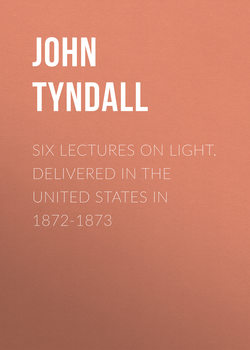Читать книгу Six Lectures on Light. Delivered In The United States In 1872-1873 - John Tyndall - Страница 16
LECTURE II
§ 5. Analogies of Sound and Light
ОглавлениеThomas Young's fundamental discovery in optics was that the principle of Interference was applicable to light. Long prior to his time an Italian philosopher, Grimaldi, had stated that under certain circumstances two thin beams of light, each of which, acting singly, produced a luminous spot upon a white wall, when caused to act together, partially quenched each other and darkened the spot. This was a statement of fundamental significance, but it required the discoveries and the genius of Young to give it meaning. How he did so will gradually become clear to you. You know that air is compressible: that by pressure it can be rendered more dense, and that by dilatation it can be rendered more rare. Properly agitated, a tuning-fork now sounds in a manner audible to you all, and most of you know that the air through which the sound is passing is parcelled out into spaces in which the air is condensed, followed by other spaces in which the air is rarefied. These condensations and rarefactions constitute what we call waves of sound. You can imagine the air of a room traversed by a series of such waves, and you can imagine a second series sent through the same air, and so related to the first that condensation coincides with condensation and rarefaction with rarefaction. The consequence of this coincidence would be a louder sound than that produced by either system of waves taken singly. But you can also imagine a state of things where the condensations of the one system fall upon the rarefactions of the other system. In this case (other things being equal) the two systems would completely neutralize each other. Each of them taken singly produces sound; both of them taken together produce no sound. Thus by adding sound to sound we produce silence, as Grimaldi, in his experiment, produced darkness by adding light to light.
Through his investigations on sound, which were fruitful and profound, Young approached the study of light. He put meaning into the observation of Grimaldi, and immensely extended it. With splendid success he applied the undulatory theory to the explanation of the colours of thin plates, and to those of striated surfaces. He discovered and explained classes of colour which had been previously unnoticed or unknown. On the assumption that light was wave-motion, all his experiments on interference were accounted for; on the assumption that light was flying particles, nothing was explained. In the time of Huyghens and Euler a medium had been assumed for the transmission of the waves of light; but Newton raised the objection that, if light consisted of the waves of such a medium, shadows could not exist. The waves, he contended, would bend round opaque bodies and produce the motion of light behind them, as sound turns a corner, or as waves of water wash round a rock. It was proved that the bending round referred to by Newton actually occurs, but that the inflected waves abolish each other by their mutual interference. Young also discerned a fundamental difference between the waves of light and those of sound. Could you see the air through which sound-waves are passing, you would observe every individual particle of air oscillating to and fro, in the direction of propagation. Could you see the luminiferous ether, you would also find every individual particle making a small excursion to and fro; but here the motion, like that assigned to the water-particles above referred to, would be across the line of propagation. The vibrations of the air are longitudinal
